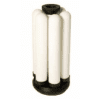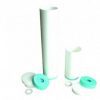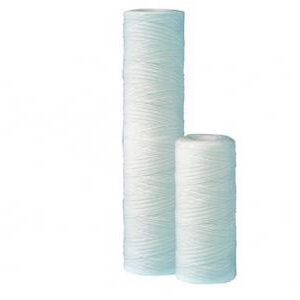Omnipure CK Series Filter Cartridge
Providing an alternative to higher priced replacement bodies. The CK-Series was developed to offer our customers an alternative to higher priced replacement bodies designed to fit existing bayonet-style permanent heads. Made of highly durable injection-moulded polypropylene, the CK-Series is constructed from 100% NSF (National Sanitation Foundation) approved materials.
Send Enquiry for Omnipure CK Series Filter Cartridge
Description
Description
The CK-Series was developed to offer our customers an alternative to higher priced replacement bodies designed to fit existing bayonet-style permanent heads. Made of highly durable injection-moulded polypropylene, the CK-Series is constructed from 100% NSF (National Sanitation Foundation) approved materials.
Omnipure offers a variety of standard media options including granular activated carbon (GAC) for taste and odour reduction, depth filtration media to address sand, grit and sediment problems that can clog or damage down line equipment and a special blend polyphospate media designed to control the scaling associated with hard water.
Carbon blocks utilizes new technology that optimizes surface area for better contaminant absorption. The OmnipureBlock™ is available in a high capacity, ten-micron activated carbon version and a water polishing, cysts reducing one-micron version. Additionally, OmnipureBlocks are available in an activated carbon/scale inhibitor version and a carbon/lead inhibitor version.
The CK-Series of replacement bodies from Omnipure…a reliable, efficient, cost-effective alternative to higher priced filter body replacements on the market.
These cartridges carry a maximum service life of approximately 1-year, dependent on usage and water quality.
Specifications
Please refer to the table below for a sample of the CK-Series cartridges we provide. For any further assistance please call us on 02 9458 1111.
| Image | Media | Size | Model | Micron | Quality/removes |
|---|---|---|---|---|---|
 |
Carbon block | 2.5” x 12” | CK5620 | 1 | Taste, odour, chlorine & cysts |
| CK5615 | 1 | Taste, odour, chlorine, cysts & lead |
|||
| Phosphate/ carbon |
2.5” x 12” | CK5621-P | 10 | Taste, odour, chlorine reduction & scale inhibitor |
Cartridge variations
Dependent on your specific filtration needs – Omnipure provide a range of cartridges specialized in removing particular contaminants.
| Quality component | Primary function |
|---|---|
| Carbon block | Taste, odour, metals and cyst removal |
| GAC | Taste, odour |
| Sediment | Dirt, sand and all particulate matter |
| Phosphate/carbon | Inhibits scale/lime build up |
| 100% phosphate | Prevents scale/lime build up |
Fittings
Applicable for these filters are a range of heads that feature the varying threads applicable to your system. The following are available:
- Valved 1/4” Head
- Valved 3/4” Head
- Non-Valved 1/4” Head
- Non-Valved 3/8” Head

| Thread | Fitting available |
|---|---|
| 1/4” Female | RH Non-Valved, RH Valved, WL Non-Valved, WL Valved |
| 3/8” Female | Non-Valved |
| 1/4” John Guest Tube | RH Non-Valved, WL Valved, WL Non-Valved |
| 3/8” John Guest Tube | WL Non-Valved |
Carbon filtering is a method of filtering that uses activated carbon to remove contaminants and impurities, taste and odour using chemical adsorption.
Each granule of carbon provides a large surface area structure, allowing contaminants the greatest possible exposure to the active sites within the filter media. One pound (450 g) of activated carbon contains a surface area of approximately 100 acres (40 Hectares).
Activated carbon works via a process called adsorption, whereby pollutant molecules in the fluid to be treated are trapped inside the pore structure of the carbon . Carbon filtering is commonly used for water purification, in air purifiers and industrial gas processing. It is also used in a number of other applications, including respirator masks, the purification of sugarcane and in the recovery of precious metals, especially gold.
Active charcoal carbon filters are most effective at removing chlorine, sediment, volatile organic compounds (VOCs), taste and odour from water. They are not effective at removing minerals, salts, and dissolved inorganic compounds. Reverse Osmosis is the best filtration for dissolved compounds.
Typical particle sizes that can be removed by carbon filters range from 0.5 to 50 micrometres. However, the amount and quality of carbon is also very important factor. The particle size will be used as part of the filter description. The efficacy of a carbon filter is also based upon the flow rate regulation. When the water is allowed to flow through the filter at a slower rate, the contaminants are exposed to the filter media for a longer amount of time.
There are 2 predominant types of carbon filters used in the filtration industry: powdered block filters and granular activated filters. In general, carbon block filters are more effective at removing a larger number of contaminants, based upon the increased surface area of carbon. Many carbon filters also use secondary media such as silver to prevent bacteria growth within the filter. Alternatively, the activated carbon itself may be impregnated with silver to provide this bacteriostatic property.
Be the first to review “Omnipure CK Series Filter Cartridge” Cancel reply
Related products
Available with or without auto shutoff, the new L-Series offers a patented design to easy change-outs with a simple one-quarter turn. Made of highly durable injection-moulded polypropylene, the L-Series is constructed from 100% NSF (National Sanitation Foundation) certified materials. We offer a variety of standard media options including granular activated carbon (GAC) for taste and odour reduction, depth filtration media to address sand, grit and sediment problems that can clog or damage down line equipment and a special blend polyphosphate media designed to control scaling associated with hard water.
Cartridge shells that can be cleaned and reused with GAC. These cartridge shells are designed to be filled with GAC for use within a Whole House/High Flow filter system. They can be washed and reused at the time of replacing the media within – providing an economic means to filtration for your entire home. GAC (Granular Activated Carbon) is simply carbon in the form of granules. This increases the surface area available for absorption of the unwanted chemicals within your water supply.
Ceramic and GAC carbon water filter cartridge. The Doulton Super Sterasyl ceramic and GAC (Granular Activated Carbon) water filter cartridge is ideal for rain/tank water use or low water pressure area. It is a highly efficient ceramic micro filter which provides genuine sub micron filtration to your drinking water.
Ideal as a pre-filter within a twin whole house/high flow system. A String Wound filter cartridge is manufactured from surfactant-free polypropylene string over a polypropylene core. The large void volume design offers low-cost, reliable filtration performance with high contaminant holding capacity.
Service and Maintenance. Water Filter replacements. Water Cooler cleaning. Repairs, installations and regular maintenance schedules. Reverse osmosis service and repairs. Zip, Supatap, Waterworks, Aqua one, All the big brands and more….
Doulton filtration for whole house/high flow application. You have a choice of Sterasyl or Supersterasyl candles. Sterasyl candle is designed for microbiological protection whilst Supersterasyl is a Sterasyl shell packed with selective activated carbon for chlorine, bad taste and odor, pesticides, herbicides and industrial solvents reduction. Due to the carbon exhaustion change Supersterasyl candles every six months.












Reviews
There are no reviews yet.